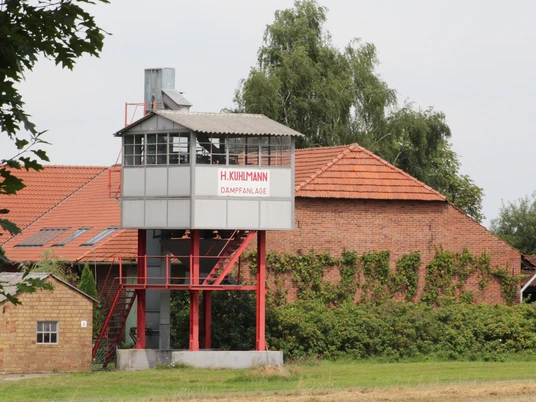Germany's only preserved and restored steaming plant is located in the municipality of Stöckse in the heart of Lower Saxony in the district of Nienburg/Weser. It has been an official cultural monument since June 2009.
Origin:
The steaming plant in the village of around 1,400 inhabitants in the district of Nienburg/Weser in the heart of Lower Saxony was not uncommon in the past. There were many plants of this type in Germany. In the second half of the last century, it was common practice to produce starch-rich feed for fattening pigs by "steaming", i.e. cooking potatoes in large containers. In the 1950s, many small farms in the countryside had their own small kettles on their floorboards in which they cooked their fodder potatoes. As livestock numbers increased, mobile steam boilers on farm wagons came into use, which moved from farm to farm and performed their duties. However, as a result of the economic upturn after the war and the accompanying boom in agriculture, this was soon no longer sufficient. In many places, stationary steaming plants with a much larger capacity were built. In the district of Nienburg/Weser alone, at least six plants were in operation.
Significance of the plant:
The heyday of potato steaming was in the 1960s. Back then, farmers even received a state bonus for a short time if they brought their potatoes to be steamed. However, with the increasing spread of industrially produced concentrated feed, the importance of steaming plants steadily declined. They were gradually shut down and demolished or fell into disrepair. As a result, the catchment area of the Stöcks plant grew continuously. Farmers interested in steaming traveled further and further. In the end, they came from a radius of over 50 kilometers to the Soltau or Minden area. With a tractor and one or two trailers, this was a lengthy round trip.
In 1996, the Stöcks plant was probably the last to cease operations. In contrast to comparable facilities of this type, however, it remained standing. The last operator, Heinrich Kuhlmann Jr., only dismantled individual parts that were potentially dangerous for children, such as the water basins for the wash water. The main part of the facility has remained in this form over the years. The Stöcks steaming plant now has a special cultural and historical significance because, according to the State Office for the Preservation of Historical Monuments, it is the last remaining plant of its kind in the whole of Germany. Since June 2009, it has therefore been recognized as a monument of agricultural industrial culture and included in the list of monuments.
Origin:
The steaming plant in the village of around 1,400 inhabitants in the district of Nienburg/Weser in the heart of Lower Saxony was not uncommon in the past. There were many plants of this type in Germany. In the second half of the last century, it was common practice to produce starch-rich feed for fattening pigs by "steaming", i.e. cooking potatoes in large containers. In the 1950s, many small farms in the countryside had their own small kettles on their floorboards in which they cooked their fodder potatoes. As livestock numbers increased, mobile steam boilers on farm wagons came into use, which moved from farm to farm and performed their duties. However, as a result of the economic upturn after the war and the accompanying boom in agriculture, this was soon no longer sufficient. In many places, stationary steaming plants with a much larger capacity were built. In the district of Nienburg/Weser alone, at least six plants were in operation.
Significance of the plant:
The heyday of potato steaming was in the 1960s. Back then, farmers even received a state bonus for a short time if they brought their potatoes to be steamed. However, with the increasing spread of industrially produced concentrated feed, the importance of steaming plants steadily declined. They were gradually shut down and demolished or fell into disrepair. As a result, the catchment area of the Stöcks plant grew continuously. Farmers interested in steaming traveled further and further. In the end, they came from a radius of over 50 kilometers to the Soltau or Minden area. With a tractor and one or two trailers, this was a lengthy round trip.
In 1996, the Stöcks plant was probably the last to cease operations. In contrast to comparable facilities of this type, however, it remained standing. The last operator, Heinrich Kuhlmann Jr., only dismantled individual parts that were potentially dangerous for children, such as the water basins for the wash water. The main part of the facility has remained in this form over the years. The Stöcks steaming plant now has a special cultural and historical significance because, according to the State Office for the Preservation of Historical Monuments, it is the last remaining plant of its kind in the whole of Germany. Since June 2009, it has therefore been recognized as a monument of agricultural industrial culture and included in the list of monuments.
Good to know
Openings
Outside visit possible at any time. Guided tour on request.
Payment methods
free of charge
Author
Mittelweser-Touristik GmbH
Lange Straße 18
31582 Nienburg/Weser
Organization
Mittelweser-Touristik GmbH
License (master data)
Mittelweser-Touristik GmbH
Nearby





